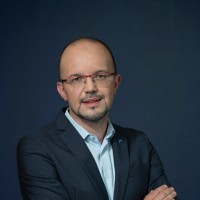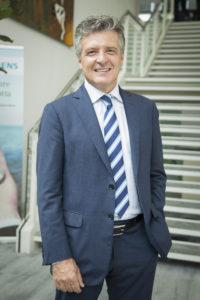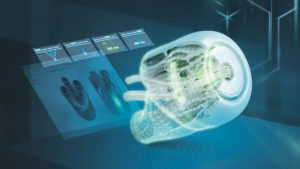
Digital Twin and 3D printing: the two cornerstones of the Siemens and Cms partnership
11 Jan 2022Digital Twin and 3D printing: the two cornerstones of the Siemens and Cms partnership
«Coming together is a beginning, staying together is progress, and working together is success» – said Henry Ford. A statement that can be used to explain the reasons behind the partnership between Cms SpA and Siemens Digital Industries Italia: what are they planning on doing, together? What are their objectives? Cms is the acronym of Costruzione Macchine Speciali. The company is based in Zogno (Bergamo) and manufactures machining centers and custom-designed systems to machine advanced materials (composites, carbon fiber, aluminum and light alloys), plastics, glass, stone and metal. Cms is part of the “Other Materials” division at the Scm Group (together with Diversified Machines Systems in North America and HG Grimme in Germany, with a turnover of 200 million and 1,000 employees. Scm, a group based in Emilia Romagna, has a turnover of 700 million with 4,000 employees and works with technologies for material processing and specializes in the production of wood processing machines.
From a technological innovation point of view, Cms aims to make a technological leap into three different areas. Firstly, the adaptive functions. They aim to study algorithms to understand if the machines’ operating parameters have any faults, so that quick intervention can be made before a stoppage occurs. And here, Siemens already has specific software, as we will see, linked to the IIoT ecosystem that includes cloud-based technologies like the MindSphere platform and Industrial Edge solutions for data processing. Secondly, the digital twin. Simulating processes before putting them into practice helps save time, money and reduce productive process inefficiencies. Once again, the German multinational has industrial software solutions that integrate the digital twin. Thirdly, additive manufacturing. In this field, the company from Bergamo has created Cms kreator, a machine with hybrid technology, 3D printing and routing, that produces large-size products (Large Format Additive Manufacturing) by positioning layers of reinforced thermoplastic material. A specific software is needed to optimize the process, like Siemens’ NX.
All this coming soon. The partnership, however, has been in place for 46 years and, during that time, Cms has diversified the product and its target sectors; so, it needed and needs a target reference company for automation with transversal skills for the various divisions. After all, the philosophy of Siemens itself is to establish long-lasting technological partnerships to get a better understanding of its clients’ needs. One example of this collaboration is cms vm 30k, a machine that works on metal and composites, fitted with Sinumerik 840D sl numeric control (nc) that sets the foundations for the simple transfer to Sinumerik One, Siemens’ innovative Cnc with integrated digital twin. We spoke to the head of Digital Industries at Siemens SpA and president of Siemens Industry Software Srl, Giuliano Busetto and with Giovanni Negri, Cms’ CEO.
Almost half a century of partnership
- For Cms it is the breadth of Siemens’ technological solutions that counts
Giovanni Negri, Cms’ CEO
In order to understand the reasons behind the partnership, we need to delve into the past. Cms was founded 52 years ago, in 1969, by Pietro Aceti. The first machining center was produced in 1974, and the following year, Negri points out, «a Cms machine had already been fitted with the first Siemens numeric control». Between the second half of the 1980s and early 1990s, the company experienced a significant technological evolution. It manufactured the first machining center in the world that could process stone (under the Brembana label), and entered the plastic materials cutting and advanced materials processing sector: «Cms then began to get involved with composites and aluminum alloys, with target sectors such as aerospace, automotive, railways, formula 1, the nautical industry, eye wear, the production of wind turbines, construction, architecture, interior design, urban furniture and more». Expansion work was carried out at the two production plants in Zogno where more than 10 thousand Cms machines have been produced and can now be found in production departments in companies all over the world. For Negri, «over the years, our collaboration with Siemens has continued and strengthened. We needed a partner with skills that intersected with the different target departments, and this is why Siemens Digital Industries is important to us. It should also be pointed out that it is the clients who ask us to fit our machines with Siemens technology».
The application intersecting of the Siemens products is, however, only one aspect of this collaboration. The other is innovation, towards which Cms is focused and needs to overlap with extensive, experimental skills. Since 2002, the company has been part of the Scm Group - a multinational based in Rimini and owned by the Aureli and Gemmani families - and, on a wider scale, has been developing a project that uses Additive Manufacturing technologies in partnership with an important German research center, the Fraunhofer Institut, for several years now. In 2019, a new technology center was inaugurated at Zogno followed by the creation of an IoT, Cms Connect platform, that «was an important step in making so many services digital», as Negri pointed out. So, what does the immediate future hold for relations with Siemens? According to Negri, it is to take a step towards digitalization, «in fields where Siemens naturally presents itself to offer its contribution».
- The partnership according to Siemens
Giuliano Busetto, Head of Digital Industries at Siemens
The automation giant, that needs no introduction, is ready to help with Cms’ technological advancement, thanks to the solutions already developed and available on the market. «Siemens is not just a leading supplier in automation but the ideal technological partner to guide companies in their digital transformation thanks to its skills and a unique, comprehensive range of solutions that link the real world with the virtual one» said Giuliano Busetto. «Long-standing, long-lasting relationships are the best way of getting to know one another. Perseverance and commitment are the key to our partnership with Cms, a company that is part of the SCM group, active in numerous sectors of particular interest to us». So, let’s look at the solutions the multi-national has developed for the three innovation pillars pinpointed by Cms’ CEO.
Adaptive functions, digital twin and additive manufacturing: the objectives of the partnership
- The adaptive functions
According to Negri, it is not just a matter of developing algorithms capable of understanding if the machines’ parameters have faults but also about developing new digital functions that allow for processes to be optimized, so that the assistance services can intervene as required. Here, the reference to Siemens is immediate thanks to the IIoT MindSphere operating system, based on the Cloud, that can store operational information and make it accessible via specific digital apps. Thanks to this technology, it is possible to perform advanced analyses connected to the performance indicators while Industrial Edge supports the elaboration of a high number of parameters via algorithms based on statistical methods and the concept of machine learning that can predict functioning trends and faults, as well as optimize the processing itself.
- The digital twin
Sinumerik One, the first digital native cnc that wholly integrates the digital twin
In the context of digital transformation, the machine’s digital twin is, for Cms, a key step, as it allows for an exact and digital replica to be made of the machine itself, of what happens during a specific processing and what are the stages in optimizing the process: all this without physically processing anything in the workshop but simply recreating the process virtually. «Siemens – stated Negri – is highly advanced in this field». Indeed, the multinational has a Digital Enterprise Suite that offers excellent software and automation solutions just like Sinumerik One, the first digital native cnc to fully integrate the digital twin. Furthermore, the Sinumerik and NX combination means machines or machine systems can be simulated and allows for the creation of relative digital twins guaranteeing an optimization of development times; it also provides access to new business opportunities for the builder’s sales network as well as an excellent tool for the end users to train his/her operators. Lastly, it is also an effective tool to test, in a virtual environment, the machine’s functioning, programs and processing times even when it is occupied with processing.
- Additive manufacturing
In this field, the company from Bergamo is certainly not starting from scratch: we mentioned at the beginning the collaboration with the Fraunhofer Institut (and for some time now, also with the University of Trento) that led to the creation of the Cms kreator, that uses thermoplastic polymers reinforced by 40% with carbon. It works like this: the thermoplastic materials are placed in layers, one on top of the other, that contribute to creating the end product. The current dimensions of Cms kreator are impressive: 4.7 by 2 meters and will shortly achieve dimensions of 6 by 2.6 meters, in order to meet any demand from the automotive, aerospace and nautical industries. «Large-scale “slice” processing needs an advanced control software capable of optimizing the performance of our machines» - said Negri. Siemens also provides an end-to-end integrated solution for additive manufacturing, by managing the entire Cad–Cam–Cnc chain. Thanks to a unique platform, the multi-technology, or rather, machines both for removal and for deposit, right up to robots can be managed with maximum flexibility.
An example of the results of the partnership at the current time
In the field of additive manufacturing, Cms has created Cms kreator, a machine with hybrid technology, 3D printing and routing, that produces large-size products (Large Format Additive Manufacturing) by positioning layers of reinforced thermoplastic material. A specific software is needed to optimize the process, like Siemens’ NX
Vm 30k is a machine that processes the metals and composite materials. «In order to process the latter – points out Negri – there is a need for the experience that Cms has accumulated over more than 50 years, featuring sturdiness and rigidity in removal on a par with those needed to process certain metals, like steel. Course precision and accuracy are some of Vm 30k’s finest aspects». The machine is three meters long and two meters wide. The useful path is 1.3 meters «but the range it is part of also comes in larger sizes». The machine is fitted with Sinumerik 840D sl, a numeric control that guarantees speed and flexibility for different applications (lathing, routing, correction, drilling, punching and much more) of the tool machines. It has a high-performance hardware architecture and intelligent algorithms, as well as integrated safety functions for the operator and tools.
Sinumerik One
«The foundations are there for a simple transfer to the Sinumerik One cnc platform» said Negri. This is a digital native cnc that maximizes the performance of the tool machines, because it has a state-of-the-art integrated Plc that has cycle times 10 times faster than a standard Plc. Sinumerik One creates the digital twin with which it is possible to simulate the processing and the machine’s entire automation, with considerable advantages: functioning problems at the design stage can be dealt with and software can be tested together with the mechanical model, achieving a considerable reduction in the time to market. In terms of productivity, the Sinumerik One offers functionality like the Top Speed Plus, where, with the use of filters on the dynamic in play, processing times can be optimized without affecting the quality, and the Intelligent Load Control that increases the processing precision with the automatic adaptation of the adjustment parameters. There are also important new aspects with regard to the prevention of collisions, with the expansion of new features like Protect MyMachine 3D Twin, thanks to which it is possible to import the 3D models of its own models and tightening torque components and simulate the removal of material based on future and actual positions of the axes, ensuring a complete protection of the machine, bearing in mind the areas removed in any operating method; the geometries and offsets of the tools will always be updated in real time, with the support of edge computing technology.
[Republication of an article published on 3 November 2021]



